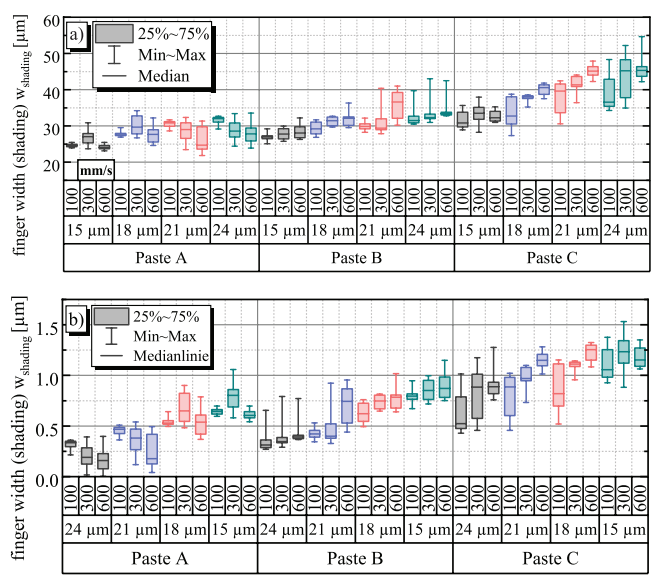
量子效率测试仪
PL/EL一体机
Sinton硅片少子寿命测试仪
Sinton硅块少子寿命测试仪
绒面反射率测试仪
3D共聚焦显微镜
清洗制绒工作站
在线四探针方阻测试仪
全自动扫描四探针方阻测试仪
在线薄膜厚度测试仪
晶化率测试仪
Horiba显微共焦拉曼光谱仪
傅里叶红外光谱仪
霍尔效应测试仪
分光光度计
全光谱椭偏仪
Horiba椭圆偏振光谱仪
TLM接触电阻率测试仪
超景深显微镜
网版智能影像测量仪
全自动影像测量仪
卧式拉力机
电池片稳态光衰老化试验箱
电池片紫外老化试验箱
电池片拉脱力综合测试仪
外观检验台
湿漏电测试系统
组件实验室EL测试仪
紫外老化试验箱
稳态光衰老化试验箱
电流连续性监测系统
PID测试系统
旁路二极管测试系统
LeTID测试系统
反向电流过载系统
脉冲电压测试系统
绝缘耐压测试仪
接地连续性测试仪
绝缘耐压接地测试仪
湿热环境试验箱
湿冻环境试验箱
热循环试验箱
动态机械载荷测试机
静态机械载荷测试机
冰雹冲击试验机
引出端强度试验机
霰弹冲击试验机
抗划伤(切割)测试机
剥离试验机
万能材料试验机(单臂)
万能材料试验机(双臂)
光伏玻璃透过率测试仪
醋酸测试试验箱
交联度测试系统
二极管接线盒综合测试仪
落球冲击试验机
半自动四探针
全自动探针式台阶仪
多通道太阳能MPPT系统
Horiba稳瞬态荧光光谱仪
钙钛矿P1激光划线测试仪
钙钛矿在线膜厚测试仪
钙钛矿工艺检测工作站
手持式IV测试仪
便携式EL测试仪
手持热成像测试仪
户外组件IV测试仪
户外组件多通道测试系统
光伏逆变器电能质量测试仪
无人机EL检测仪
丝印速度、网版开口宽度对光伏电池栅线的影响
日期:2024-08-23浏览量:35
硅太阳能电池的金属化过程中,银作为浆料的主要成分,降低银消耗且不影响电池效率是重要目标。通过丝网印刷银电极的表征等实验,由此得知网版开口宽度的减小会导致电阻增加、栅线宽度变化等,这些都说明了网版线宽对印刷结果和太阳能电池性能的重要性。美能网版检测仪AVT-4030集四大检测功能为一体,用于检测太阳能电池网版的各项特征包括:尺寸、缺陷、张力、膜厚,通过测量检测,帮助客户分析及改善制程,以提高电池片印刷质量。

丝网印刷银电极的表征
从电阻、栅线宽度、光电纵横比等多个方面对丝网印刷银电极的表征进行了分析,揭示了印刷速度、网版开口宽度等因素对电池片栅线性能的影响。
平均横向栅线电阻:
对于每种浆料(A、B、C)展示了12个单独的子组,每个子组对应不同的网版开口宽度Wn和印刷速度 Vprinting。对于每个组,展示了中位数、最小-最大值范围以及平均横向栅线电阻在8-10个太阳能电池的120根栅线上的25 - 75% 四分位数(取决于制造过程中的硅片损耗)。

平均横向栅线电阻RL
比较两种不同丝印网版的网格架构(380/0.014和480/0.011),当超过一定阈值时,网格架构的差异对电阻的影响较小。网版开口宽度Wn的减小会导致印刷结构的横截面积减小,从而限制横向导电性,使平均横向栅线电阻RL增加。印刷速度 Vprinting 的增加会导致栅线几何形状受到更大的扩展,从而增加平均横向手指电阻RL。
印刷速度对栅线宽度的影响
不同浆料(A、B、C)12个单独的子组呈现出网孔,范围从15到24 μm,印刷速度Vprinting范围从100到600 mms-1。
通过比较不同浆料(A、B、C)的复剪切模量比值,可以解释印刷速度对栅线宽度的影响。

不同浆料与印刷栅线宽度和相对扩展系数的关系
印刷速度对不同浆料印刷栅线宽度的影响不同。浆料 A 的栅线宽度在印刷速度增加时无明显变化;浆料 B 开始出现明显相关性,栅线宽度随印刷速度增加而增加;浆料 C 在印刷速度增加时导致过度扩展。
相对扩展系数与浆料特性有一定关联,且较小的网格指宽度会导致相对扩展增加。印刷速度、浆料的特性以及网格指宽度大小等因素共同影响着印刷栅线的宽度和扩展行为。
印刷速度对光学和电学纵横比的影响:
不同的浆料(A、B、C)以及不同网格架构(380/0.014 和 480/0.011),三种不同的印刷速度(100到600 mm s-1)对应的光学纵横比和电学纵横比。

(a)光学纵横比 ARo(b)电学纵横比 ARel
浆料 A 的纵横比偏差比浆料 C 明显增大,这表明纵横比的偏差依赖于浆料的特性。上图的数据结果表明,纵横比受到浆料的屈服应力、印刷速度以及浆料特性产生影响,另外网格架构差异对纵横比的影响较小。
丝网印刷的可重复性与稳定性
图a栅线高度的相对偏差与栅线宽度的相对偏差之间的关系,来展示过程的可重复性。图b中每个点代表一个显微镜图像,点的分布形成的数据用于评估过程的稳定性。

(a)浆料-网版界面的粘附功与印刷栅线高度的偏差(b)横截面积的偏差之间的关系
栅线高度的平均偏差与从网版表面分离浆料所需的功密切相关。随着每通道网版表面面积上的粘附功增加,印刷栅线高度的偏差也增大。粘附功与栅线高度偏差呈现较为一致的变化趋势,说明在一定程度上丝网印刷过程中某些因素的影响具有可重复性。观察图b数据点的分布情况,如果数据点分布较为集中,形成较为紧密的数据集合,说明在不同的实验条件下,栅线高度和宽度的变化具有一定的规律性,即丝网印刷过程在这两个方面具有较好的可重复性。
丝网印刷工艺

丝网印刷模型示意图
进行丝网印刷时,设计印刷图案并制作成网版。印刷时,在网版上铺展浆料,刮刀的刀刃紧贴网版的丝网表面横向刮动浆料,并施加适当的压力使网版与硅片接触,将浆料挤出网孔后黏附在硅片上。因为网版与硅片之间留有间隙,网版将利用自身的张力与硅片瞬间接触后立即脱离硅片回弹,挤出网孔的浆料与丝网分离,在硅片表面按照网版的图形限定区域黏附浆料。
网版开口宽度和栅线宽度在丝网印刷硅太阳能电池金属化过程中起着至关重要的作用。通过优化这两个参数,并结合浆料的特性和印刷速度等因素,可以提高丝网印刷的性能和稳定性,为硅太阳能电池的高效生产提供有力支持。
美能网版智能检测仪

联系电话:400 008 6690
美能网版检测仪AVT-4030集四大检测功能为一体,用于检测太阳能电池网版的各项特征包括:尺寸、缺陷、张力、膜厚。采用0.1μm光栅尺,实现线宽测量精度0.3μm,PT值测量精度2μm,提升网版质量。
n 尺寸、缺陷、膜厚、张力检测集成化
n 网版检测规格:≤220*220mm(尺寸可定制)
n 高分辨光学系统,精度高、连续性强、成本低、灵活性好
网版作为太阳能电池片栅线印刷工艺环节的重要模具,网版开口宽度对印刷过程有着显著影响。不同的网版开口宽度与栅线宽度相互作用,影响着浆料在丝网印刷过程中的流动和转移特性。网版的质量好坏直接影响电池片栅线质量,从而对太阳能电池片产生影响。「美能光伏」网版检测仪配置丰富,一机多用,将尺寸、缺陷、膜厚、张力检测集成化,通过测量及数据统计分析功能,帮助客户分析及改善制程。




































































